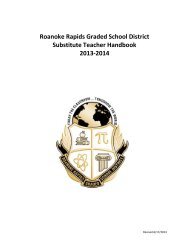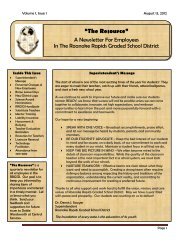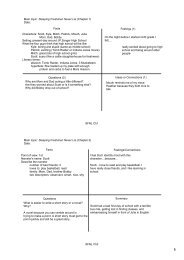Revised Dress Code Regulation - Roanoke Rapids Graded Schools
Revised Dress Code Regulation - Roanoke Rapids Graded Schools
Revised Dress Code Regulation - Roanoke Rapids Graded Schools
- No tags were found...
Create successful ePaper yourself
Turn your PDF publications into a flip-book with our unique Google optimized e-Paper software.
<strong>Revised</strong> September 17, 2012EMPLOYEE DRESS AND APPEARANCE <strong>Regulation</strong> <strong>Code</strong>: 7340-RThe objective of the <strong>Roanoke</strong> <strong>Rapids</strong> <strong>Graded</strong> School District (RRGSD) in establishing guidelinesfor professional dress is to allow its employees to work comfortably in the work place whileprojecting a business image. It is important that RRGSD’s employees project a professionalimage for its students, parents, community, and visitors. Business style is the standard for thisdress code.Because all casual clothing is not suitable for the educational setting, these guidelines will helpemployees to determine what is appropriate to wear to work. Obviously, clothing that is suitablefor the beach, yard work, dance clubs, exercise sessions, sports contests, etc. may not beappropriate for the professional work environment.Clothing that reveals too much cleavage, your back, your chest, your feet, your stomach, or yourunderwear is not appropriate for work. Generally, in a business work environment, clothingshould be pressed and never wrinkled. Torn, dirty, or frayed clothing is unacceptable. All seamsmust be finished. Any clothing that has words, terms, or pictures that may be offensive to otheremployees is unacceptable.Guide to Business Style <strong>Dress</strong>ing for WorkThis is a general overview of appropriate business attire. Items that are not appropriate for theeducational setting are listed, too. Neither list is all-inclusive and both are open to change. Thelists tell you what is generally acceptable as business attire and what is generally not acceptable.No dress code can cover all contingencies so employees must exert a certain amount ofjudgment in their choice of clothing to wear to work. If you experience uncertainty aboutacceptable, professional business attire for work, please ask your supervisor or the HumanResources Department at Central Services.Slacks and PantsSlacks that are made of cotton or synthetic material pants, wool pants, flannel pants, and nicelooking dress synthetic pants are acceptable along with dress/Bermuda style shorts.Inappropriate slacks or pants include jeans, sweatpants, exercise pants, short shorts, biboveralls, leggings, and any spandex or other form-fitting pants such as people wear for biking.(jeans, sweatpants, etc. may be worn contingent upon work assignments).Skirts, <strong>Dress</strong>es, and Skirted SuitsCasual dresses and skirts that are split at or below the knees are acceptable. <strong>Dress</strong> and skirtlength should be at a length at which you can sit comfortably in public. Short, tight skirts thatride halfway up the thigh are inappropriate for work. Mini-skirts, skorts, sun dresses, beachdresses, and spaghetti-strap dresses are inappropriate for the educational setting.
<strong>Revised</strong> September 17, 2012Shirts, Tops, Blouses, and JacketsCasual shirts, dress shirts, sweaters, tops, golf-type shirts, and turtlenecks are acceptable attirefor work. Most suit jackets or sport jackets are also acceptable attire for the educational setting,if they violate none of the listed guidelines. Inappropriate attire for work includes tank tops;midriff tops; shirts with potentially offensive words, terms, logos, pictures, cartoons, or slogans;halter-tops; tops with bare shoulders. Sweatshirts and t-shirts are acceptable when worn todemonstrate school spirit or unity.Shoes and FootwearConservative athletic or walking shoes, loafers, clogs, boots, flats, dress heels, and leather decktypeshoes and/or sandals are acceptable for work. Flip-flops and slippers are not acceptable inthe educational setting. Closed toe and closed heel shoes are required in the areas whereOccupational Safety and Health Administration (OSHA) rules apply.Jewelry, Makeup, Perfume, and CologneShould be in good taste, with limited visible body piercing. Remember, that some employees areallergic to the chemicals in perfumes and make-up, so wear these substances with restraint.Hats and Head CoveringHats are not appropriate in the educational setting. Head Covers that are required for religiouspurposes or to honor cultural tradition are allowed.OtherClothing items worn to honor religious and/or cultural tradition are permissible if they satisfyother dressing requirements described herein.ConclusionIf the supervisor determines that the employee’s dress or appearance violates the establishedguidelines or is hazardous to the health or safety of the employee, fellow employees or students,the supervisor shall counsel the employee regarding attire that is consistent with this policy andshall determine whether the employee is allowed to remain at work or must leave work tochange his or her dress. Any failure to follow the supervisor's directive and/or blatant orrepeated violations of this policy will subject the employee to disciplinary action up to, andincluding, dismissal.





